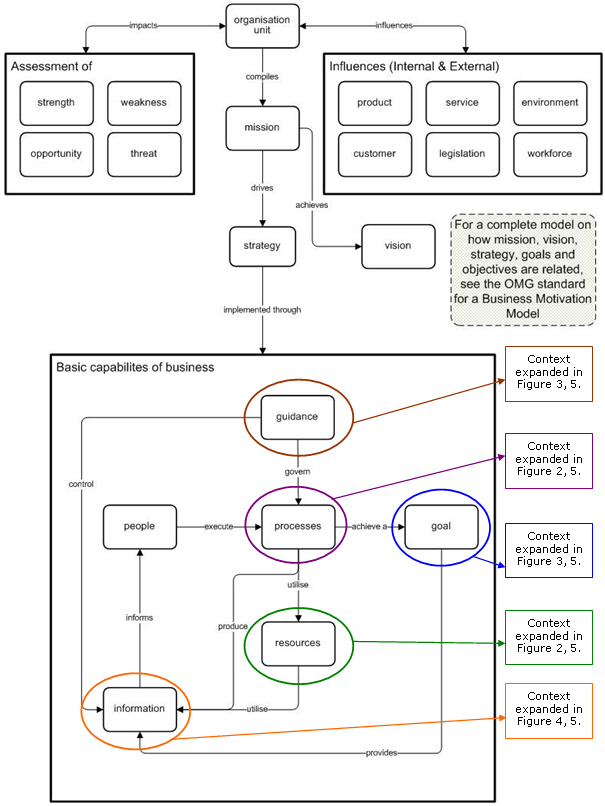In the transition from the Information Age to the Process Age, we need new thinking and methods to design products and services for the agile business environment. Processes demand a new paradigm that expects more from managing a business and creating solutions than the current information-oriented paradigm. We need methods that are fit for working with processes to replace our methods for working with information, as they aren’t built on the necessary concepts. As organisations mature in the Process Age, they will distinguish themselves from those that rely solely on information based concepts to build a competitive advantage.
An organisation’s maturity in utilising processes in the Process Age can be plotted against its ability to utilise and manage the five basic capabilities for high performance: People, Guidance, Processes, Information and Resources (Figure 1):
- The organisation comes into existence because of People generating ideas. People, especially the customers, are the beginning and ending of the very existence of the organisation, because processes don’t do work – people do.
- Guidance is the foundation of the organisation and encapsulates the motivation and the business rules of an organisation. It is derived from the vision, mission, strategy, goals and objectives and influenced by internal and external influences. It guides, constrains, controls and ensures fairness for all in the organisation. The guidance also determines what services the organisation will provide to achieve its vision. Guidance enforces compliance through its application as governance. (Figure 3)
- Processes steer the organisation to be more effective, efficient and competitive. It not only executes the guidance in an optimal way, but also co-ordinates and aligns all activities in the organisation. It ensures that everything the organisation does is linked to its strategy by enforcing compliance to the governance. Processes enable the services of the organisation. (Figure 2, 5)
- Information is the building blocks for the organisation’s growth and expansion. It provides the source that feeds the organisation’s knowledge which can be turned into intelligence that builds wisdom. It is an account of the history of the organisation and provides insight into the possible future for the organisation. Information is controlled, utilised and produced by people through the processes of the organisation. (Figure 4)
- Resources make it possible for the organisation to produce the products and services that it intends to deliver to satisfy customers. Resources are used in (input) or utilised by (mechanisms) processes. (Figure 2)
- All five capabilities are essential to every organisation and are interconnected. Their interdependence is the fundamental nature of any organisation and forms the culture of the organisation. They enable the organisation to effectively and efficiently achieve its goals. Managing these five capabilities in an integrated environment that is conducive to high performance and that meets the demands of an agile business environment, is the essence of Integrated Business Management.
The full potential of Integrated Business Management offers a strategic capability for achieving breakout competitive advantage through process innovation. The scope and complexity will increase exponentially as organisations progress from point-solution information systems to organisation-wide process-oriented systems where cross-functional processes are taken on. This will continue on to organisation-wide business service management where totally new cross-organisation services emerge and must be managed.
It’s about competing for the future in the new era of extreme competition, where the customer is no longer king; the customer is now a dictator that demands the organisation to provide cheaper, better, faster products and services. This can only be accomplished through innovative process-oriented thinking.
In short, Integrated Business Management
- Implements Enterprise Architecture from a service- and process-oriented paradigm focussed on successful customer outcomes.
- Shapes business design and systems engineering from a service, process and human performance and interaction perspective.
- Enables systems to dynamically change to adapt to a dynamically changing business.
- Incorporates the management of business into the execution of business processes.
In the next article I will elaborate in more detail on some of the concepts shown in the attached figures and discuss how process-oriented concepts and systems engineering practices can be used in a process-oriented engineering methodology.
Words in Pictures


















